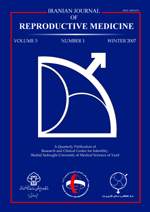
|
International Journal of Reproductive BioMedicine
Research and Clinical Center for Infertility, Shahid Sadoughi University of Medical Sciences of Yazd
ISSN: 1680-6433
EISSN: 1680-6433
Vol. 16, No. 10, 2018, pp. 641-648
|
 Bioline Code: rm18077
Bioline Code: rm18077
Full paper language: English
Document type: Research Article
Document available free of charge
|
|
|
International Journal of Reproductive BioMedicine, Vol. 16, No. 10, 2018, pp. 641-648
| en |
Antioxidant effects of calligonum extract on ovarian tissue of PCO model: An experimental study
Tahmasebi, Fatemeh; Movahedin, Mansoureh & Mazaheri, Zohreh
Abstract
Background: Polycystic ovary syndrome (PCO) is one of the most common reasons
for infertility. Calligonum as a plant possess some of the important antioxidants that
can decrease oxidative stress.
Objective: The effects of treatment with Calligonum as an antioxidant on ovary
tissue of a PCO mouse model.
Materials and Methods: Thirty female NMRI mice were divided into three groups
(n=10/each): control, PCO, and Calligonum. We induced PCO model with single
dose of Estradiol valerate (40 mg/kg). Then Calligonum (20 mg/kg) was
intraperitoneally injected weekly for two months. The level of oxidative stress and
total antioxidant capacity was assessed in the ovarian tissue by flow cytometry and
fluorescence recovery after photobleaching, respectively, and the histological study
was conducted by the morphometric method and embryo development with in vitro
fertilization.
Results: The obtained results showed that estradiol valerate was able to increase
oxidative stress within the ovary and causes ovarian cysts after two months. The cyst
formation was decreased in Calligonum group compared to PCO group (p=0.001).
The percentage of pre-antral and antral follicles significantly decreased in
Calligonum group compared to PCO group (p=0.001). The oxidative stress
decreased in Calligonum group significantly compared to PCO group (p=0.001).
Calligonum can significantly increase the total antioxidant capacity of ovarian tissue
(p=0.001) as well as the percentage of in vitro fertilization compared to the PCO
group.
Conclusion: Calligonum could decrease ovary cyst in PCO model, and improve in
vitro fertilization rate. Also, Calligonum extract as an antioxidant could decrease
oxidative stress in PCO model.
Keywords
Polycystic ovary syndrome; Antioxidant; In vitro fertilization; Mouse; Calligonum.
|
| |
© Copyright 2018 - International Journal of Reproductive BioMedicine
Alternative site location: http://www.ijrm.ir
|
|
